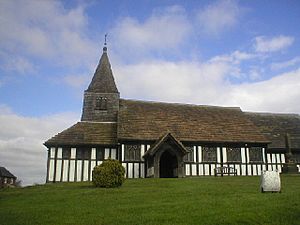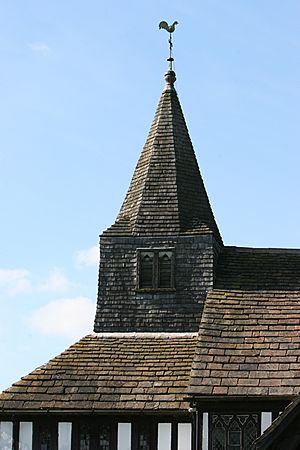St James' and St Paul's Church, Marton facts for kids
Quick facts for kids St James' and St Paul's Church, Marton |
|
|---|---|

St James' and St Paul's Church, Marton, from the south
|
|
| Lua error in Module:Location_map at line 420: attempt to index field 'wikibase' (a nil value). | |
| OS grid reference | SJ 849 680 |
| Location | Marton, Cheshire |
| Country | England |
| Denomination | Anglican |
| Website | Marton, St James and St Paul |
| History | |
| Status | Parish church |
| Architecture | |
| Functional status | Active |
| Heritage designation | Grade I |
| Designated | 14 April 1967 |
| Architect(s) | J. M. Derick, William Butterfield |
| Architectural type | Church |
| Specifications | |
| Materials | Timber framing, rendered brick infill, slate roof |
| Administration | |
| Parish | Marton |
| Deanery | Congleton |
| Archdeaconry | Macclesfield |
| Diocese | Chester |
| Province | York |
The Church of St James and St Paul is a special church. It is located south of the village of Marton, in Cheshire, England. This church is part of the Anglican faith. It was built a very long time ago, in the 14th century. Today, it is listed as a Grade I building on the National Heritage List for England. This means it is a very important historical building.
The church is still an active parish church. This means it serves the local community. It is part of the Diocese of Chester. This church is quite unique because its main structure is made of wood. It is one of the oldest timber-framed churches in Europe. Only a few churches like this still exist in England. Other examples are found in places like Lower Peover and Baddiley in Cheshire.
Contents
History of the Church
The church was first built in 1343. It was started by Sir John de Davenport and his son Vivian. They also gave money to help the church. More land was given by their family in 1370.
The belfry, which holds the bells, was added later. It was built around the year 1540. In 1804, the church's roof was made lower.
Changes and Repairs Over Time
The church has been repaired and updated many times. J. M. Derick worked on it in 1850. Then, William Butterfield did more work in 1871. Derick changed some windows to let in more light. Butterfield made some of the wooden parts in the tower look neater. The main entrance at the west end was also added around this time.
More repairs happened in 1930 and 1931. During these repairs, some wall panels and roof parts were replaced. The wooden shingles on the belfry were also renewed. A brick section was added to the chancel (the part of the church near the altar) in the 20th century.
Church Design and Features
Outside the Church
The church's outer walls are made of a wooden frame. This frame has many closely spaced wooden posts. It sits on a stone base. The spaces between the wood are filled with brick covered in stucco (a type of plaster). The roof is made of slate.
At the west end, there is a square tower covered in wooden shingles. On top of the tower is a pointed roof called a broach spire. It has a weather cock at its very top. This tower is surrounded by smaller roofed sections on the north, west, and south sides. The tower has an arched door from the 20th century. This door has old iron hinges from the 17th century.
The main part of the church has a nave (the central area) with three sections. It also has aisles on the north and south sides. There is a chancel with two sections and chapels at the ends of the aisles. A porch is on the south side. One expert said the outside of the church was "disappointing." They felt the changes made in the 1800s made it look less like a medieval building. However, they noted that the inside has "a great deal of character and interest."
Inside the Church
Inside, the wooden piers (support columns) are shaped like octagons. In the belfry, there are two damaged stone statues. These statues are from the 14th century and show knights. Their heads rest on the Davenport family symbol. This suggests they might be statues of the church's founders, John and Vivian de Davenport.
The pulpit (where sermons are given) has a coat of arms and was made in 1620. There are three old bells still working. The oldest bell has the words 'God Save the Queen and Realme 1598' written on it. Other interesting items include an Elizabethan parish chest. There is also an old handmade wooden ladder. This ladder is used to reach the bell-ringing platform. The organ was built in 1894 by A. Worral. The church has a set of six bells. Three of these bells are dated 1598, 1663, and 1758. The church's parish registers, which record births, deaths, and marriages, started in 1563.
Old Paintings and Art
Inside the church, you can see parts of old medieval paintings. These were found on the west wall in 1930. The painting likely shows the Last Judgement. This was a common subject for church paintings in the Middle Ages. The painting is divided into sections by the wooden beams.
At the top right, there is a male figure with a halo and long yellow hair. This might be Christ. Across from him, a kneeling female figure with a halo could be the Virgin Mary. The bottom left part of the painting shows figures with their hands raised. They are mostly looking towards the viewer. These might be souls being judged. Other figures are carrying items, possibly symbols of the Passion.
The church also has an 18th-century oil painting. It was painted by Edward Penney. This painting shows Moses and Aaron holding the Ten Commandments.
Outside the Church Grounds
In the churchyard, there is a cross. It dates from the 14th or 15th century. It has been repaired since then. This cross is also listed as a Grade II historical item. The churchyard is also the resting place for two soldiers who died in World War I.
See also
- Grade I listed buildings in Cheshire East
- Grade I listed churches in Cheshire
- Listed buildings in Marton, Cheshire


